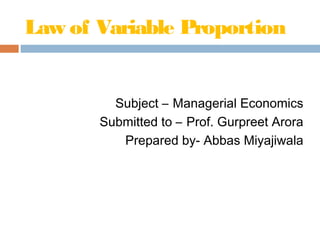
Presentation on law of variable proportion
- 1. Law of Variable Proportion Subject – Managerial Economics Submitted to – Prof. Gurpreet Arora Prepared by- Abbas Miyajiwala
- 2. CONTENTS: Production Function Two Types of Production Function Two Types of Factor Inputs Total, Average and Marginal Product Assumption of the Law Three Stages of Production The Law of Variable Proportion
- 5. Production Function Production Function can be represented in form of mathematical model of equation as Q= f( a,b,c, ….., etc) Here, Q is dependent variable which stands for Quantity of Output and a,b,c are independebt variables and various Factors of Inputs like Land, Capital, Labour, etc which are used in production.
- 6. Two types of Production function Short Run Long Run
- 7. Short Run Production Function In this case, the producer will keep all his fixed factors constant and will only change a few variable factor inputs. For example, the Law of Variable Proportion.
- 8. Long Run Production Function In this case, the producer will vary all his factor inputs both fixed as well as variable. For example, The Law of Returns to the scale.
- 9. Two types of FactorInputs Fixed Input : Quantity of which remains the same irrespective of level of output produced by the firm. For example, Land, Building, Machineries, etc. Variable Inputs : Quantity of which varies the level of output produced by the firm. For example, Raw Materials, Power, Fuel, Transport , Labour, etc.
- 10. Total Product (TP) It refers to the total volume of goods produced during a specified period of time. Total Product(TP) can be raised only by increasing the quantity of variable factors employed in production.
- 11. Average Product (AP) Average Product can be known by dividing total product by the total number of units of the variable factor. TP/Q EG- 450/5 = 90
- 12. Marginal Product (MP) It is the output derived from the employment of one additional unit of variable factor. The rate at which the total product increases is known as marginal product. Addition to the total product resulting from a unit increase in the quantity of the variable factor.
- 13. Three Stages of Production
- 14. TOTAL PRODUCT WORKER PRODUCT 1st STAGE Increasing Returns 2ND STAGE Decreasing Returns 3RD STAGE Negative Returns AVEARGE PRODUCT MARGINAL PRODUCT
- 15. Stage I (Increasing returns) Marginal product is increases throughout. This means that every additional unit increases productivity as well as total output. This is shown on the graph by an increasing slope of total Product curve.
- 16. Stage II (Diminishing returns) Marginal product decreases throughout. This means that every additional unit decreases productivity, though total output still increases. This is shown on the graph by a decreasing positive slope of total product curve.
- 17. Stage III (Negative returns) Marginal product is negative throughout. This means that each additional unit actually decreases total output. A waste of money and resources. This is shown on the graph by a negative slope.
- 18. Conclusions fromthe diagram The greatest productivity is at the end of Stage I. The greatest output is at the end of Stage II. Therefore, Stage II is ideal because there is a balance between productivity and total output.
- 19. Assumptions of the Law of Variable Proportion Only one factor is variable while others are held constant. All units of variable factors are homogeneous. There is no change in technology. It is possible to vary proportions in which different inputs are combined. The products are measured in physical units, i.e. in quintals, tonnes etc.
- 20. The Law of Variable Proportion “ In a given state of technology and keeping other productive factors constant, additional units of a particular variable input will yield increasing returns of variable factor up to a point. Eventually a point is reached beyond which further additions of variable factor yield diminishing marginal returns per unit of input ”
- 21. Law of Variable Proportion It explains the relationship between factor input and factor output in physical terms. It helps in selecting the most ideal combination of factor inputs. It is the new name for the famous “ Law of Diminishing Returns” by Classical Economists.
- 22. THANKYOU
